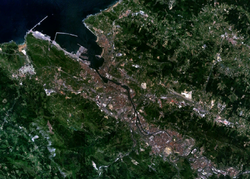Greater Bilbao


Greater Bilbao (Basque: Bilbo Handia, Spanish: Gran Bilbao) is a metropolitan area of Biscay, Spain. It is also called Metropolitan Bilbao and is constituted by a set of municipalities along the Nervion River ending at its mouth, that due to their growth have gotten physically united looking like a single city (see conurbation), plus some satellite towns.
Geography
It's the sixth most populated metropolitan area of Spain, with over 900,000 inhabitants, which is the most part of the 1,100,000 inhabitants of the Biscay province (the city of Bilbao has 353,000) and almost half of the Basque Country's population. The region's municipalities, as defined by the Basque Country's Territorial Directives, are: Abanto y Zierbena, Alonsotegi, Arrankudiaga, Arrigorriaga, Barakaldo, Barrika, Basauri, Berango, Bilbao, Derio, Etxebarri, Erandio, Galdakao, Getxo, Górliz, Larrabetzu, Lejona, Lemoiz, Lezama, Loiu, Muskiz, Ortuella, Plentzia, Portugalete, Santurtzi, Sestao, Sondika, Sopelana, Ugao-Miraballes, Urduliz, Valle de Trápaga-Trapagaran, Zamudio, Zaratamo and Zeberio.
Some towns that form part of other regions can be considered inside the metropolitan area as satellite towns, because of their intense dependency in transport, commerce and leisure. These towns are: Mungia, Lemoa, Amorebieta, Durango in Biscay and Laudio in Alava.
The area is structured into different zones:
- The city of Bilbao: main hub of the metropolitan area.
- The left bank: Traditionally industrial, port, and manufacturing zone including towns like Barakaldo, Sestao, Portugalete or Santurce.
- The right bank, more residential: Erandio, Leioa and Getxo.
- The mining zone, where the main iron ore resources were located: Muskiz, Gallarta, Ortuella
- Txoriherri, wide expansion zone where the international airport and the University of the Basque Country are located.
- Hego Uribe, including Basauri, Galdakao or Arrigorriaga.
- Uribe-Kosta: the coastal area north of Getxo is being integrated into the metropolitan area in the recent years, with the development of low density residential areas connected by the metro.
Urban Regeneration
The main municipalities of the region and metropolitan area, Bilbao and Barakaldo, and the Basque and Spanish Governments constituted in 1992 the organization Bilbao Ria 2000 for the city-planning regeneration of Bilbao and its surroundings, indeed being these the municipalities more punished by the intense industrial activity and the great amount of contaminated grounds and industrial ruins that derived from that activity. Among the projects that it has impelled this institution is the recovery of Abandoibarra, once industrial ground and the place where the Guggenheim Museum Bilbao and the Euskalduna Palace are located now.
In parallel exists the association Bilbao Metropoli-30, constituted in 1991 by the City council of Bilbao, Biscay and Basque Governments and diverse public and private organizations for the regeneration of Metropolitan Bilbao.
The area is since 1995 fully interconnected by the Metro Bilbao.
Municipalities of the Bilbao Metropolitan Area
- Bilbao Metropolitan Area (35 municipalities)
| Abanto y Zierbena | 18.0 km² | 9,503 | 527.9 /km² |
| Alonsotegi | 16.0 km² | 2,745 | 171.6 /km² |
| Arrankudiaga | 20.8 km² | 4,018 | 193.2 /km² |
| Arrigorriaga | 22.8 km² | 12000 | 341 /km² |
| Barakaldo | 24.3 km² | 95,260 | 3,920.2 /km² |
| Barrika | 7.8 km² | 1,337 | 171.4 /km² |
| Basauri | 7.2 km² | 44,052 | 6,118.3 /km² |
| Berango | 8.8 km² | 5,904 | 670.9 /km² |
| Bilbao | 41.3 km² | 353,173 | 8,551.4 /km² |
| Derio | 7.4 km² | 5,030 | 679.7 /km² |
| Etxebarri | 3.3 km² | 7,707 | 2,335.5 /km² |
| Erandio | 18.0 km² | 23,338 | 1,296.6 /km² |
| Galdakao | 31.7 km² | 29,594 | 933.6 /km² |
| Górliz | 10.2 km² | 4,882 | 478.6 /km² |
| Getxo | 11.9 km² | 82,687 | 6,948.5 /km² |
| Larrabetzu | 21.5 km² | 1,647 | 76.6 /km² |
| Leioa | 8.5 km² | 28,858 | 3,395.1 /km² |
| Lemoiz | 14.3 km² | 925 | 64.7 /km² |
| Lezama | 16.5 km² | 2,287 | 138.6 /km² |
| Loiu | 15.3 km² | 2,205 | 144.1 /km² |
| Muskiz | 20.8 km² | 6,682 | 321.3 /km² |
| Ortuella | 7.7 km² | 8,554 | 1,110.9 /km² |
| Plentzia | 6.3 km² | 3,949 | 626.8 /km² |
| Portugalete | 3.2 km² | 49,788 | 15,558.8 /km² |
| Santurce(Santurtzi) | 7.2 km² | 47,155 | 6,549.3 /km² |
| Sestao | 3.5 km² | 30,350 | 8,671.4 /km² |
| Sondika | 6.3 km² | 4,300 | 682.5 /km² |
| Sopelana | 8.4 km² | 11,469 | 1,365.4 /km² |
| Ugao-Miraballes | 5.2 km² | 4,060 | 780.8 /km² |
| Urduliz | 7.8 km² | 3,241 | 415.5 /km² |
| Trapagaran | 13.1 km² | 12,580 | 960.3 /km² |
| Zamudio | 18.1 km² | 3,176 | 175.5 /km² |
| Zaratamo | 10.0 km² | 1,624 | 162.4 /km² |
| Zeberio | 47.1 km² | 1,027 | 21.8 /km² |
| Total | 494.7 km² | 906,390 | 1,832.2 /km² |
- Satellite towns (5 municipalities)
| Amorebieta | 16,800 |
| Durango | 26,131 |
| Laudio | 18,623 |
| Lemoa | 2,831 |
| Mungia | 14,052 |
| Total | 78,437 |
| Total Met. Area | 984,827 |

